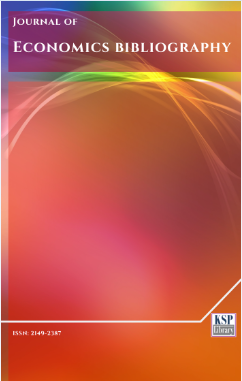Nonlinear Trend and Purchasing Power Parity
Abstract
Abstract. After the collapse of the Bretton Woods system, the evidence on the purchasing power parity (PPP) in the long run is still a matter of debate. The difficulties of the problem are the possible nonstationarity of relative price indices and nominal exchange rates. The traditional ways to deal with nonstationarity such as unit root model and cointegration have some problems. In this paper, to deal with nonstationarity, we apply the Hodrick-Prescott (HP) trend-cycle filter in real business cycle literature (Hodrick and Prescott, 1981) which can give a nonlinear smooth-trend, and we find that after the 1970s float, the monthly HP trends of US dollar/UK sterling and Deutsche marks/US dollar have certain relevance with their corresponding HP trends of relative consumer price indices. This result indicates that there is no strong evidence to directly deny that the PPP is valid in the long run. In this sense, it is not reliable to directly deny the belief of monetary neutrality!
Keywords. HP filter, Purchasing power parity, Monetary neutrality.
JEL. C00, C01, C20, C30.
Keywords
References
Balassa, B. (1964). The purchasing power parity doctrine: A repraisal, Journal of Political Economy, 72(6), 584-596. doi. 10.1086/258965
Blatt, J.M. (1978). On the econometric approach to business-cycle analysis, Oxford Economic Papers, 30, 292-300 (1978).
Bierens, H.J. (1995). Testing the Unit Root Hypothesis against Nonlinear Trend Stationary, with an Application to the U.S. Price Level and Interest Rate, Working Paper, No. 9507, Southern Methodist University, Dallas, Texas.
Campbell, J.Y., & Perron, P. (1991). Pitfalls and Opportunities: What Macroeconomists Should Know about Unit Roots, NBER Macroeconomics Annual 1991, O.J. Blanchard & S. Fisher (Eds)., MIT Press, Cambridge.
Chen. P. (1996a). Trends, Shocks, Persistent Cycles in Evolving Economy: Business Cycle Measurement in Time-Frequency Representation, In: W.A. Barnett, A.P. Kirman, & M. Salmon, (Eds), Nonlinear Dynamics and Economics, chapter 13, Cambridge: Cambridge University Press.
Chen, P. (1996b). Random walk or color chaos on the stock market? - Time-Frequency Analysis of S&P Indexes, Nonlinear Dynamics & Econometrics, 1(2), 87-103. doi. 10.2202/1558-3708.1014
Chen, P. (1999). Complex Dynamics in Economic Organisms: The Origin of Division of Labor and the Nature of Persistent Business Cycles. CCER Working Paper, #E1999015, Peking University, Beijing, China.
Day, R., & Chen, P. (1993) Nonlinear Dynamics and Evolutionary Economics, Oxford University Press, New York.
Dornbusch R. (1976). Expectations and exchange rate dynamics, Journal of Political Economy, 84(6), 1161-1176. doi. 10.1086/260506
Engle, R.F., & Granger, C.W.J. (1987). Cointegration and error correction: Representation, estimation and testing, Econometrica, 55(2), 251-276. doi. 10.2307/1913236
Frenkel, J. (1981). The collapse of purchasing power parity during the 1970s. European Economic Review, 16(1),145-165. doi. 10.1016/0014-2921(81)90055-6
Froot, K., & Rogoff, K. (1995). Perspective on PPP and long-run real exchange rates, Handbook of International Economics, 3, 1647-1688. doi. 10.1016/S1573-4404(05)80012-7
Hodrick, R.J., & Prescott, E.C. (1981). Post-war US business cycle: An empirical Investigation, Discussion Paper, No. 451, Canegie-Mellon University.
Isard, P. (1995). Exchange Rate Economics, Cambridge University Press.
King, R.G., & Rebelo, S.T. (1993). Low frequency filtering and real business cycles, Journal of Economic Dynamics and Control, 17(1-2), 207-231. doi. 10.1016/S0165-1889(06)80010-2
Nelson, C.R., & Kang, H. (1981). Spurious periodicity in inappropriately detrended time series, Econometrica, 49(3), 741-751. doi. 10.2307/1911520
Nelson, C.R., & Plosser, C.I. (1982). Trends and random walks in macroeconomic time series, some evidence and implications, Journal of Monetary Economics, 10(2), 139-162. doi. 10.1016/0304-3932(82)90012-5
Papoulis, A. (1977). Signal Analysis, New York: McGraw-Hill.
Perron, P. (1989). The great crash, the oil price shock and the unit root hypothesis, Econometrica, 57(6), 1361-1401. doi. 10.2307/1913712
Rogoff, K.(1996). The purchasing power parity puzzle, Journal of Economic Literature, 34(2), 647-667.
Samuelson, P. (1964). Theoretical notes on trade problems, Review of Economics and Statistics, 46(2),145-154. doi. 10.2307/1928178
Taylor, M. (1995). The economics of exchange rates, Journal Economics Literature, 33(1),13-45.
DOI: http://dx.doi.org/10.1453/jeb.v3i3.1001
Refbacks
- There are currently no refbacks.
.......................................................................................................................................................................................................................................................................................................................................
Journal of Economics Bibliography - J. Econ. Bib. - JEB - www.kspjournals.org
ISSN: 2149-2387.
Editor: [email protected] Secretarial: [email protected] Istanbul - Turkey.
Copyright © KSP Library

